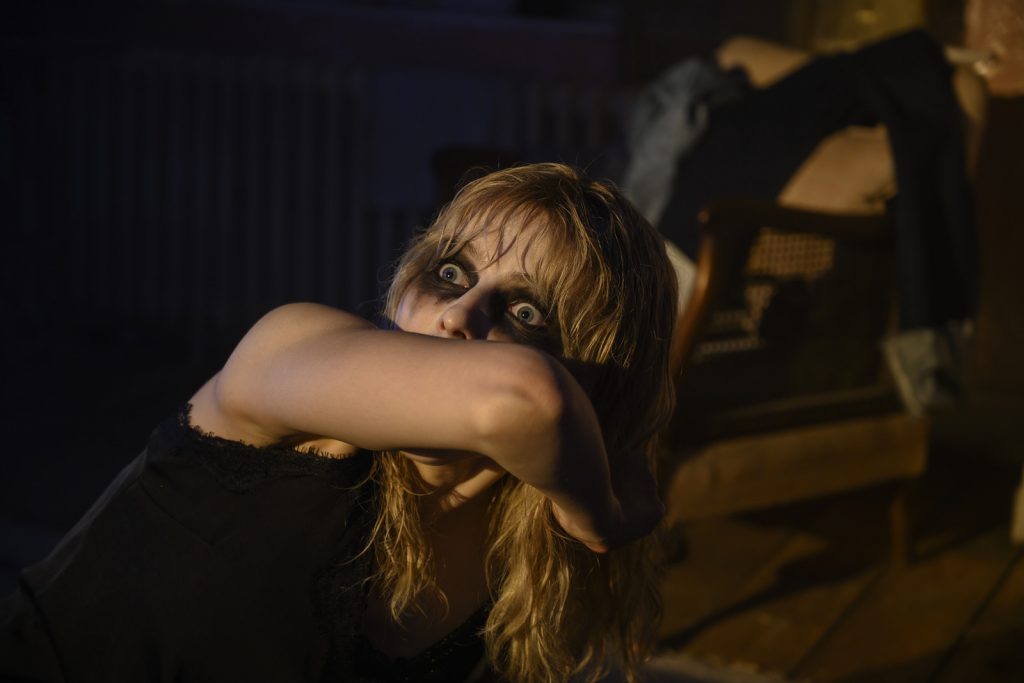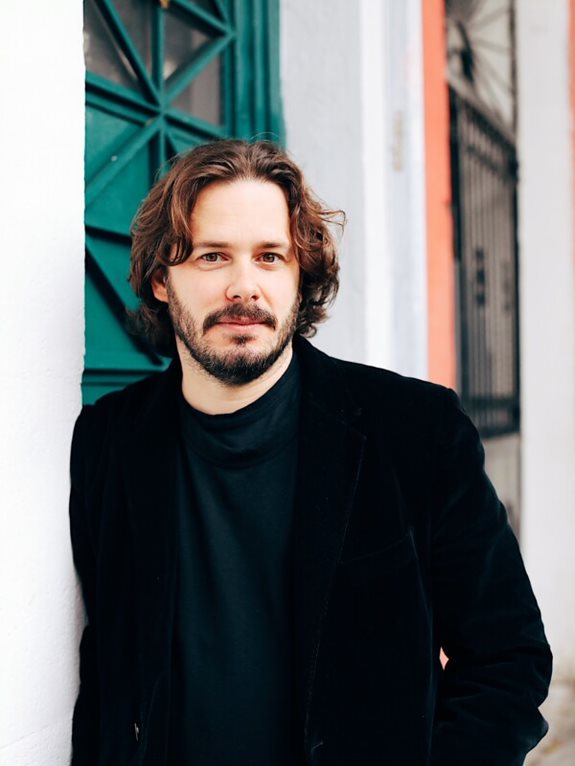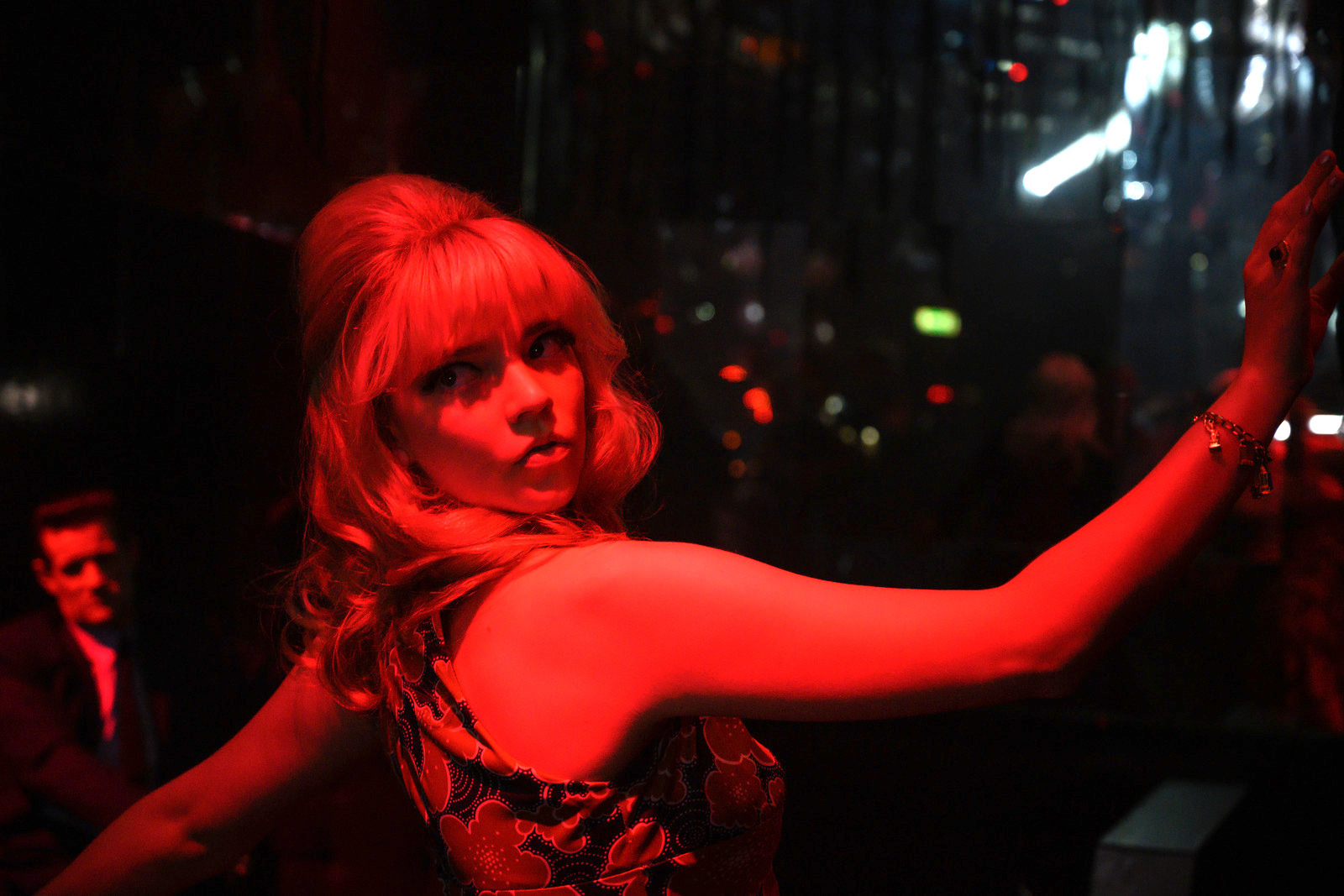“It stretches back at least 10 years,” said Edgar Wright about the story idea for Last Night in Soho. “There are a couple of inspirations for it, like an unhealthy obsession with the 60s that started with my parents’ record collection.”
Edgar, who is well known for his musical taste in movies like Shaun of the Dead, Scott Pilgrim, and Baby Driver, seems to write, direct, and edit with the score or soundtrack in mind. “There’s this feeling that I missed out on the coolest decade, just before me,” he said.
“Then, moving to London, as a twenty-year-old and spending an inordinate amount of time in Soho, which has been an inspiration for artists for 400 years… it’s this place where the entertainment district and the criminal underworld mix.”
With this setting in mind, Edgar eventually crafted the character of Eloise (Thomasin McKenzie), an aspiring fashion designer who discovers she can enter the 1960s, essentially through the life of a dazzling wannabe singer named Sandie (Anya Taylor-Joy), until the glamour of this world “splinters into something darker.”
“I’d formulated the story and pitched it ten years ago, where I had hired researchers to research the story. I wanted to make it, but I hadn’t started the screenplay yet. I guess the missing piece of the puzzle was meeting Krysty in 2016.”
Krysty Wilson-Cairns, who has writing credits for Penny Dreadful, and 1917, was introduced to Edgar while he was editing Baby Driver by their mutual friend Sam Mendes (Skyfall, 1917). “Sam is a mutual friend and said we should get together.”

Krysty Wilson-Cairns (Photo by Ken Dundas)
The duo met in Soho, where Edgar soon pitched Krysty the general idea for Last Night in Soho. Since the pair were both somewhat obsessed with Soho, it only made sense for them to eventually work together on this project.
“I remember being totally and utterly entranced by it,” said Krysty. “Some of that was the gin and tonic, but 99 percent was the story itself,” she joked. A few months later, Edgar sent Krysty his outline, some DVDs to watch, and a playlist for the film.
Serial Killer Aesthetics & Index Cards
Once Krysty signed on to write the screenplay, she joked the next meeting involved a “serial killer aesthetic” where Edgar had storyboarded all of the beats of the film on the wall with index cards. “I think [he] was worried I was going to run when I saw that, but that’s my aesthetic as well,” she said.
“It was 40 index cards,” he elaborated, “…10 for Act 1, 20 for Act 2, and 10 for Act 3, and lots of extra index cards, sort of like a cloud diagram. And, different color coding.” Part of this helped separate the two worlds of Eloise and Sandie.
“We spent maybe six weeks writing the first draft. We had a lot of fun. Eating candy. Listening to music,” said Krysty. “Very often, the neighbors would complain, like when we would play ‘Puppet on a String’ [by Sandie Shaw] seven times in a row.”
Logistically, the writers jumped back and forth as to who was typing and who was scribbling down notes. “We were almost always in the same room writing it. There were loads of discussions,” she said. “Naturally, you also feel cabin fever, so we would wander around Soho and grab a coffee. That would help with the creative juices.”
“A lot of it early on was just talking around the story, in terms of detail,” said Edgar. “A lot of personal stuff comes into that, which I felt was inspiring working with Krysty. You have a fictional story, but you can plug your own life into that. Then, the treatment and the outline gets bigger, so one of us would have a go at [writing that scene], but it’s really about talking enough until the outline becomes the draft.”
“There were times when the treatment started to burst at the seams,” said Krysty. On some occasions, this meant frantically writing down ideas, camera movements, and every other little element that makes up an Edgar Wright movie.
“I feel the point where it becomes a screenplay is when the story can only be told by dialogue, because there’s story in terms of plot, but even when Simon [Pegg] and I used to write, there’s a certain point where the lines dictate the plot. It’s how something hinges on something else. Dialogue makes the screenplay write itself.”
The Edgar Wright Playlist
Edgar Wright is famously known for unique transitional scenes, verbal comedy, and musical elements. For Krysty to match this style, she said much of it does come out on the page. “It was in the story before I even came onboard.”
The key to any good screenplay is that it reads visually – Krysty Wilson-Cairns
She continued, “It should cater to all of those things. Having the playlist before we put pen to paper was different for me. Having been a fan of Edgar, I knew the caliber and level of visual acumen that was going to be required, so I came in ready to up my game for that. But having the playlist helped me with the tone and pacing of scenes.”
“Knowing this song is going to play at X or this section of the song is going to play really allowed me as a writer to throw myself into it. I had never written listening to music [before]. I write in total silence, like a strange Benedictine monk,” she joked. “But having those songs and beats and rhythm informed the dialogue.”
All of this informed the characters on the screen. “It isn’t a two-hander in the way you think it’s going to be, in terms of what you think it’s going to be, and obviously something happens that robs you of that, or robs our heroine of that,” said Edgar.
“In a sense, we make people think there are two plot lines, but as the 60s flashbacks take a downward slide, they get faster, and you’re not sure what time frame they’re occurring in. That was something deliberate, that at the midpoint, things would take a darker turn.”

Eloise (Thomasin McKenzie) Photo by Parisa Taghizadeh
“Eloise experiences the memories but she doesn’t have the full context of the events, and neither do we an audience. So, you’re watching what’s happening on a visceral level without ever knowing the whole story.”
Expanding Sadie
Originally, the Sandie character was more of an icon than a character in her own right. “Krysty suggested that we should hear her speak. I think in my original outline, you saw her in these dreams, but didn’t necessarily see her speak. But, when you have this twist in the second half, the person you’re aspiring to be is disappearing down the drain.”
As the story moves into more of a straight horror, it becomes quite different from Edgar’s other works, which are mainly known for comedy-horror, particularly the “Three Flavours Cornetto Trilogy,” consisting of Shaun of the Dead, Hot Fuzz, and The World’s End.
According to Edgar, fans online have been looking for more of a straight horror from him. “If anything, fans have been asking for a straight horror film, but Shaun of the Dead is a horror-comedy, where things do take a grim turn in the final act. But, [Soho] isn’t really a straight horror film. It’s a genre-bend in itself.”
Overall, he pitched the story as is and the studios supported the genre shift the writers delivered. As for Edgar’s many hats as a writer, director, and editor, he sees some scenes – around seven for Soho – as “necessary amputations” to make the best final edit.
“The edit is the final draft. There was one particular scene in Soho that, on paper, was really well written, but when we shot it, I think the actors did a great job, but in the screening, it was clear that we didn’t need the scene. I felt like we had been nudged a little from notes to expand something we didn’t need to expand. When we showed it to an audience, that’s what they thought as well,” said the writer/director.

Sadie (Anya Taylor-Joy). Photo by Parisa Taghizadeh
“Obviously in retrospect, if you knew you didn’t need that scene, you would save yourself half a day shooting it, but sometimes a scene like that, that doesn’t really need to be in the movie, helps the actors. It helps them wrap their heads around their characters, so it’s an interesting part of the process. So we cut what wasn’t necessary, but also did some reshoots to help improve it with surgical bits of dialogue. That was like the final draft.”
Opening the Film
“I could never teach a screenwriting course, because I don’t know what my own rules are,” joked Edgar. “There’s the Robert McKee thing of establishing theme in the first five minutes, and I think you can do that with visuals. Most screenwriting books focus on dialogue, but as a director and writer, I’m trying to tell the story visually.”
According to the writer/director, the whole film is about the “difference in perception and reality.” For Last Night in Soho, the opening has “this silhouette shot of someone in an amazing ball gown, like a Hollywood 50s musical, but when she switches the lights on, she’s in this mundane corridor in her house, wearing a dress made of newspaper.”
Shaun of the Dead opens on Shaun somewhat ignoring his girlfriend while his friend Ed obnoxiously plays an arcade game in their favorite bar nearby. “With Shaun of the Dead, the opening scene is sort of a parted version of the rest of the movie, where everything that occurs sort of happens in the opening scene,” said Edgar.
Likewise, with Baby Driver, we see Baby as the get-away driver obsessed with music, who is far different and more playful than his bank-robbing colleagues. “Without dialogue, you see what he’s like with these other criminals and what he’s like when no one else is watching. He’s stoic and he’s a goofball. That’s the movie: who is he and who does he want to be?”

Eloise (Thomasin McKenzie) Photo by Parisa Taghizadeh
Krysty added, “I think with Baby or Eloise, it’s about letting the audience into their world in a way that feels real and whole. It’s not through dialogue or an explosion. I think that’s what the first ten pages have to do: give you a character you’re connected to, to move through this world with.”
Choosing Projects
Edgar Wright carried the ideas for Baby Driver and Last Night in Soho for nearly a decade. “I guess it’s a nagging thing. If it won’t go away, you know you have to do the movie. Both Baby Driver and Soho, there was a nagging sense where I had to make the movie. I don’t want to make a childbirth analogy, but at some point, it’s out of your control. The film is haunting you at some point.”
“I couldn’t get Last Night in Soho out of my head. I told people the story like a campfire tale. At some point, you have to go for it. As a writer, I think the thing you do early on is that you want to write less and achieve more. With things I had written before, you see how over-written they are. It’s like you’re trying to sell people on the idea that you’re a writer, rather than writing a good screenplay.”

Edgar Wright
As a Director, Edgar sees massive blocks of prose as a turnoff in spec scripts. “I look at people who can write stage direction really well, like Walter Hill, James Cameron or Quentin Tarantino or Shane Black. It doesn’t even describe everything that is happening. It’s sort of the snap of what you are going to see on screen. That’s more important than overdoing it on the prose.” Edgar added that in the Scott Pilgrim script that he co-wrote with Michael Bacall, the goal was to write the tone of the fights without having to explain the full fight scenes.
Krysty said, “For me, the best thing I’ve learned is to let actors act. I’m in a very fortunate position working with Sam and Edgar where there are stellar casts. Sometimes I’ll write something and then on set, you realize a good actor and good director can get that with a look. I love watching them cut dialogue on set, because it is a visual medium. Telling it in a look makes me look better,” she joked.
In another example of minimalism, Edgar said there was a full page monologue in A Fistful of Dollars, but Clint Eastwood asked Sergio Leone if he could rewrite the backstory. “He was supposed to give this monologue to the romantic lead and he changed the whole monologue to, ‘I used to know a girl like you.’ Usually actors go the other way,” he joked.
Final Cuts
“I think there’s a notion that [scripts] need to be shorter, and that’s kind of wrong,” said Krysty. “It doesn’t need to be shorter. It just needs to read visually. Everyone reading it needs to play a movie in their head. With 1917, specifically, it’s camera angles and shots, but I didn’t want to put that in the script. That technical language reminds people they’re reading a technical document as opposed to something about emotion, character, and a journey.”
“I spend a lot of time writing and rewriting prose. I find dialogue quite easy,” she added. “Dialogue, you hear every day of your life. I was a weird kid who eavesdropped on buses, but when you get the character right, you hear them in your head. But prose, I think, is where your script can be perfect or broken. It’s a make or break. I overwrite, then spend a lot of time stripping it back.”
Krysty said it’s fine for there to be twenty lines of dialogue, as long as readers are forced to lean into the work. “I don’t mind a bank of prose as long as they’re good.” Visually, she also likes the “jigsaw puzzle look” of a script that has been well crafted with prose and dialogue.
“I try to make stage directions more succinct because I have an OCD thing about a word over-hanging on the next line,” said Edgar. “People get wise to you changing the tabs, so I try to think of how to get rid of one word. It’s like playing fucking Tetris,” he joked. Krysty added, “We absolutely did a Tetris pass on this, but changing the tab is cheating.”
As for writerly advice, Krysty likes to read screenplays to movies she had never seen before. In addition, if a script she wrote got made but didn’t come out the way she had it in her mind, she would look back at her screenplay to see how she could better craft her true interpretation. “Where did I go wrong? How could I write this in an undeniable way?”
Edgar said he never set out to be a screenwriter, but he realized it was a necessity for him and Simon Pegg to sit down and write their own work. “Read screenplays. Watch movies and break them down. Me and Simon would watch classic films and break them down. Not cynical, but more to understand how things work and how many durations there are in every sense. Take a favorite film and dismantle it.”
This interview has been condensed. Listen to the full audio version here.

